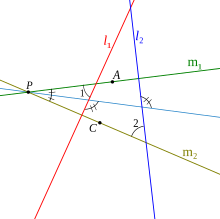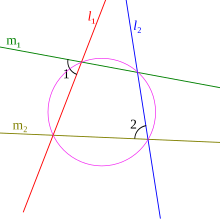In geometry, two lines and are antiparallel with respect to a given line if they each make congruent angles with in opposite senses. More generally, lines and are antiparallel with respect to another pair of lines and if they are antiparallel with respect to the angle bisector of and
In any cyclic quadrilateral, any two opposite sides are antiparallel with respect to the other two sides.
Relations
- The line joining the feet to two altitudes of a triangle is antiparallel to the third side. (any cevians which 'see' the third side with the same angle create antiparallel lines)
- The tangent to a triangle's circumcircle at a vertex is antiparallel to the opposite side.
- The radius of the circumcircle at a vertex is perpendicular to all lines antiparallel to the opposite sides.

Conic sections
See also: Circular section § Elliptical coneIn an oblique cone, there are exactly two families of parallel planes whose sections with the cone are circles. One of these families is parallel to the fixed generating circle and the other is called by Apollonius the subcontrary sections.
 |
 |
 |
If one looks at the triangles formed by the diameters of the circular sections (both families) and the vertex of the cone (triangles ABC and ADB), they are all similar. That is, if CB and BD are antiparallel with respect to lines AB and AC, then all sections of the cone parallel to either one of these circles will be circles. This is Book 1, Proposition 5 in Apollonius.
References
- Heath, Thomas Little (1896). Treatise on conic sections. p. 2.
- Blaga, Cristina; Blaga, Paul A. (2018). "Directed Angles" (PDF). Didactica Mathematica. 36: 25–40.
- A.B. Ivanov: Anti-parallel straight lines. In: Encyclopaedia of Mathematics - ISBN 1-4020-0609-8
- Weisstein, Eric W. "Antiparallel". MathWorld.
External links
 Media related to Antiparallel lines at Wikimedia Commons
Media related to Antiparallel lines at Wikimedia Commons
 and
and  are antiparallel with respect to a given line
are antiparallel with respect to a given line  if they each make
if they each make  and
and  if they are antiparallel with respect to the
if they are antiparallel with respect to the 


 in the opposite senses with the bisector of that angle.
in the opposite senses with the bisector of that angle.
 .
.